Optimal Fins for Ocean Swimming: A Comprehensive Guide
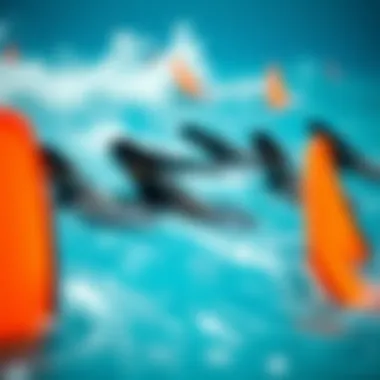
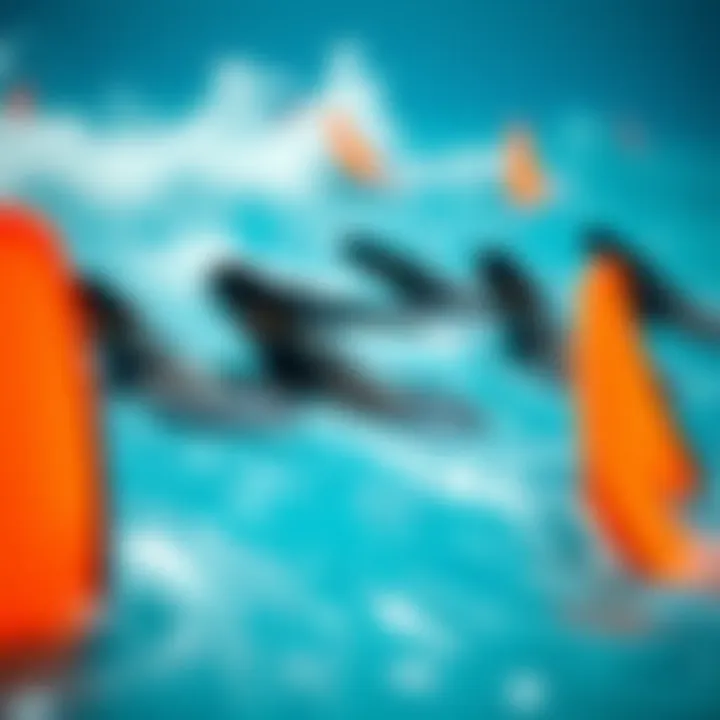
Intro
Choosing the right fins for ocean swimming isn't just a matter of preference. It can mean the difference between a delightful experience and an arduous one. With the vast expanse of ocean waters and the myriad conditions one may encounter, having appropriate fins can significantly enhance both performance and safety.
Different fin types are crafted for various purposes; some are designed for speed while others offer more control or comfort. Materials matter as well; they can affect buoyancy, flexibility, and durability. Understanding these factors, along with personal swimming style and the local environment, is essential for making an informed choice.
Ultimately, it's about enhancing your interactions with the ocean, whether you're swimming leisurely, engaging in competitive events, or simply exploring underwater wonders. The right fins can be a game changer, allowing for effortless propulsion and maneuverability.
Tips and Techniques
Beginner Tips for Watersports
For those just dipping their toes in the world of ocean swimming, selecting the right fins can be a somewhat daunting task. A few practical insights can help ease the process:
- Start with Open-Toe Fins: They are often more comfortable and versatile for beginners. They allow for a better fit and can accommodate different foot shapes.
- Choose Shorter Fins: These provide adequate propulsion without overwhelming a novice swimmer. They facilitate learning and help in developing proper kicking techniques.
- Consider a Training Purpose: Opt for fins that help build strength and improve technique. Some fins are designed specifically for drills, enhancing kick mechanics or body positioning.
Advanced Techniques for Mastery
Once you've dipped your toes in and gained some experience, advancing your fin selection can further hone your skills. Here are some techniques for mastery:
- Experiment with Long Blade Fins: These fins can significantly enhance speed and allow for greater propulsion when used correctly. They demand a refined kicking technique, which leads to improved strength and efficiency.
- Use Swim Fins for Speed Work: Different types of fins enable swimmers to focus on speed drills without compromising form. The added resistance can lead to greater overall improvements.
- Incorporate Specific Drills: Combining fins with drills targeting certain strokes or techniques can yield significant gains, whether it’s isolating the kick or focusing on stroke mechanics.
Safety and Gear
Essential Safety Practices
Safety should always be a priority while swimming in open waters. Here are some safety practices to consider:
- Swim with a Buddy: Having someone with you can help mitigate risks associated with strong currents or unexpected incidents.
- Know the Local Environment: Awareness of tides, currents, and local wildlife is crucial. Understanding these elements can prevent dangerous situations.
- Wear Bright Colors: Visibility is key. Wearing brightly colored fins or gear can help others see you in the water, particularly in busy areas.
Gear Reviews and Recommendations
When it comes to choosing the right fins, thorough reviews can provide valuable insights. Here are a couple of recommended brands:
- Cressi: Known for durable construction, Cressi fins are popular among both beginners and experienced swimmers for their comfort and performance.
- Mares: This brand offers a range of fins that cater to different skill levels; from beginner to advanced, their products focus on efficiency and propulsion.
For in-depth reviews, check resources like Reddit or dedicated forums where experienced swimmers share their insights.
"The ocean holds many secrets, but good gear lets you unveil them."
In summary, whether you're just starting out or looking to master ocean swimming, understanding fin types and their applications can significantly shape your experience. Be it through enhancing your skills, ensuring safety, or simply enjoying the swim, careful fin selection is paramount.
Understanding Ocean Swimming
Ocean swimming is a unique and exhilarating experience that sets itself apart from pool workouts and lake dips. For enthusiasts, awareness of what makes ocean waters distinct is key—and here, understanding is not just about enjoying the surroundings but also about maximizing performance.
One major element to grasp is the varying nature of ocean waters. Whether it's the calming embrace of a tranquil bay or the tumultuous surf of a rocky beach, each environment requires swimmers to adapt. The density of saltwater differs from freshwater, meaning buoyancy plays a critical role in swimming efficiency. Notably, this natural buoyancy can elevate a swimmer, potentially reducing fatigue over long distances.
By understanding how these ocean elements function individually, swimmers can tailor their techniques, adjust their training, and make choices related to equipment—like fins—effectively. The benefits of mastering these nuances extend beyond the water as well; they weave into the fabric of safety, preparation, and overall enjoyment.
The Nature of Ocean Waters
The ocean is a vast body teeming with diverse conditions that can shift dramatically, even within a single day. Swimmers must be attuned to the changing tide and weather patterns. For instance, water temperatures can vary, with surface temperatures often significantly warmer than deeper layers.
Additionally, salinity affects the swimmer's buoyancy, granting an advantage in floatation. This phenomenon, often unrecognized, can affect the efficiency of strokes and the energy expended on longer swims. Ocean currents and waves likewise play a substantial role. Current direction can dictate the trajectory of a swimmer near the shore, while waves require swimmers to use more energy to navigate through or over them.
Understanding these characteristics leads to more effective training and a more enjoyable experience. Being well-versed in the specifics of ocean water properties allows swimmers to adapt their methods accordingly, enhancing comfort and performance.
Challenges Faced by Swimmers
While ocean swimming may appear blissful on the surface, it certainly comes with its hurdles. One of the most notable is the unpredictability inherent in open waters. Currents can change in an instant, and rip tides can sweep even the most seasoned swimmers off course.
Physical endurance also faces a test in the ocean. Milder tides can exhaust swimmers faster than anticipated, particularly in the presence of waves. The ocean requires not just physical prowess but also mental resilience. Overcoming fear—be it of the open water itself or of forming discomfort with changing conditions—is key to mastering this sport.
In addition, the presence of marine life can foster anxiety or hesitation; encounters with jellyfish or sharks, albeit rare, can create real concerns for swimmers. Moreover, visibility can dramatically decline throughout the day and especially at depths, which complicates both navigation and performance.
The psyche plays a large role after all. Therefore, preparing for these challenges requires meticulous planning and smart practice. This preparation is crucial for safety, enjoyment, and success in ocean swimming. Swimmers who take on these challenges emerge not just as better athletes but also as more confident individuals equipped to tackle various aquatic endeavors.
Significance of Fins in Swimming
When it comes to swimming in the ocean, having the right fins is not just a matter of preference but a strategic decision that can greatly determine the success of the experience. Fins, while often overlooked by casual swimmers, play a pivotal role in enhancing the overall aquatic journey. Their significance lies deeply rooted in how they improve not only performance but also safety and confidence in the water.
Fins serve multiple key purposes. First and foremost, they amplify propulsion, allowing for faster and more efficient movement through water. This is particularly beneficial in open water environments where current and waves can strain a swimmer's efforts. The correct fin design can translate into shorter swim times and greater endurance.
Moreover, fins contribute to boosting stability in turbulent waters. They provide a wider surface area, enabling improved balance and reducing the likelihood of being tossed around by waves. For instance, a swimmer tackling choppy ocean conditions can find peace of mind knowing their fins are helping to keep them upright.
In addition to propulsion and stability, increasing maneuverability is another significant advantage of using fins. In a dynamic aquatic setting, being able to turn and adapt to changing conditions swiftly is critical. Fins facilitate quick direction changes, helping swimmers navigate around obstacles or adjust their path in response to currents.
In sum, the significance of fins in swimming cannot be understated. They are not merely accessories but essential tools that enhance performance, safety, and enjoyment in the ocean. For anyone serious about their ocean swimming endeavors, understanding the importance of fins is the first step toward making an informed choice for their aquatic equipment.
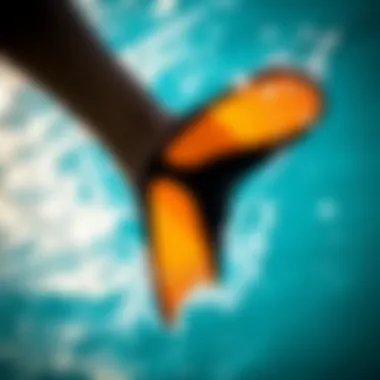
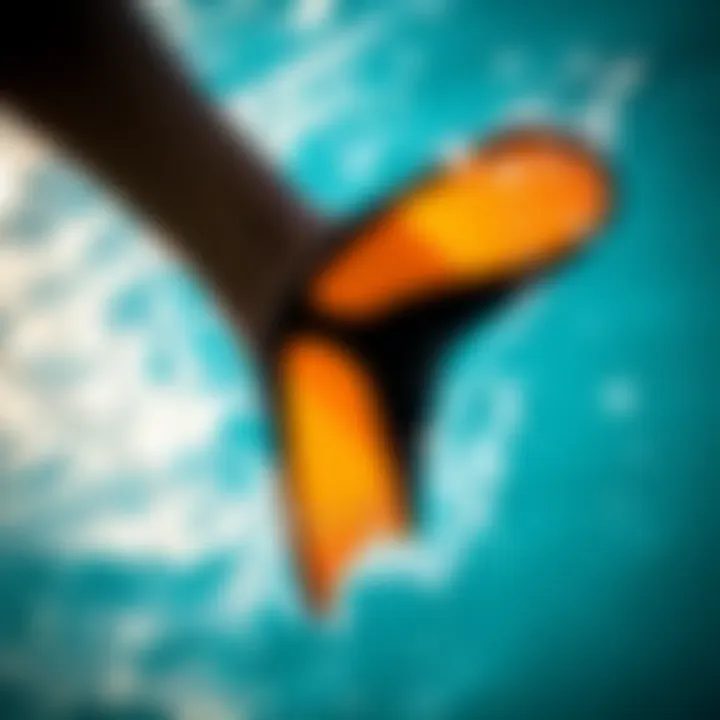
Enhancing Propulsion
One of the primary reasons swimmers opt to use fins is their ability to enhance propulsion through the water. Fins work by increasing the surface area of the foot, allowing for a more forceful push against the water. When a swimmer kicks their legs, each stroke becomes exponentially more effective, leading to a smoother and faster glide.
For example, swimmers equipped with long fins often report the sensation of gliding effortlessly, and this can be especially apparent when tackling long-distance swims. The additional propulsion cuts down on fatigue, allowing for a more enjoyable experience.
Boosting Stability
Stability is of utmost importance when navigating ocean waves. Without fins, even skilled swimmers can struggle to maintain their balance amidst unpredictability of the water. Fins enhance stability by providing structural support and a wider balance base. The design allows swimmers to feel more secure, which is imperative when dealing with turbulent conditions. For instance, being able to maintain a steady posture when catching a wave or braving tricky currents can be the difference between a thrilling experience and an alarming one.
Increasing Maneuverability
Maneuverability is key for ocean swimmers, especially when responding to unpredictable conditions. Fins empower swimmers to turn swiftly and change direction with ease. Consider a scenario where a swimmer spots a sudden rip current or a fellow swimmer in distress. The ability to quickly pivot and orient oneself can be lifesaving. Fins act like rudders, making it simpler to navigate through busy waters, dodge obstacles, or make quick exits when necessary. Thus, they contribute not just to performance but also to safety.
"Fins may seem like an extra piece of gear, but they can fundamentally reshape how one interacts with the water."
Types of Fins Available
Choosing the right type of fins is a crucial aspect of enhancing your ocean swimming experience. Fins are not merely accessories; they act as extensions of your legs, allowing for greater propulsion, stability, and comfort while navigating the waters. Depending on your style, skill level, and specific conditions faced in the ocean, the type of fin can significantly impact your performance.
Let’s delve into three primary categories: full foot fins, open heel fins, and the debate between short fins versus long fins.
Full Foot Fins
Full foot fins are designed to fit snugly over your feet. These lightweight options typically have a closed heel and are often favored by recreational swimmers. One of the advantages of full foot fins is their simplicity. They offer a streamlined fit that can improve speed through the water without creating drag.
Additionally, they are often made from softer materials, which can make them more comfortable for extended use. Many swimmers appreciate that they also provide a sense of warmth in cooler waters, which can be quite beneficial during those brisk early morning swims.
Common considerations include:
- Ease of Use: Minimal adjustments needed; simply slip them on.
- Warmth: Great for cooler temperatures where foot insulation is a plus.
- Maneuverability: They can be less cumbersome when making quick turns or adjustments compared to open heel varieties.
Open Heel Fins
Open heel fins feature an adjustable strap that allows for a more customized fit. They are typically preferred by those who are more serious about their swimming or perform in colder waters. This adjustability makes them versatile for different foot sizes and booties, accommodating various conditions and individual preferences.
The benefits include:
- Comfort: The adjustment feature provides flexibility for fit, reducing the risk of blisters or chafing.
- Compatibility: Pair them with neoprene booties for warmth and a better fit in colder waters.
- Enhanced Performance: Often provide better thrust due to a more secure fit and are less likely to slip off during powerful kicks.
Nevertheless, one must consider that open heel fins can let water in, which might decrease propulsion slightly.
Short Fins vs. Long Fins
When it comes to fin length, there are distinct differences between short fins and long fins, with each serving unique purposes. The selection often boils down to the swimmer's needs and the intended use.
- Short Fins: Often favored by swimmers who wish to enhance their technique, short fins promote a faster kick and improve leg strength. They are great for drills and refining stroke technique, making them popular among coaches and swimmers seeking finesse in their movements.
- Long Fins: These fins are perfect for maximizing speed and power. Long fins can drive swimmers through the water more efficiently, ideal for those who are racing or spending extended periods in the water. However, they require more energy to use, which may not be suitable for every swimmer's comfort level.
Choosing between short and long fins will ultimately depend on:
- Training Goals: Want to work on technique? Go for short fins. Looking for speed and power? Long fins might be your best bet.
- Comfort and Experience: Consider your own comfort level when experimenting with different lengths.
"The right pair of fins is like finding a good pair of shoes; it should feel natural and enhance your performance rather than hinder it."
Understanding the available types of fins allows swimmers to make informed choices tailored to their individual needs, style, and conditions faced in the ocean. Choosing the right fins is a step towards mastering the art of ocean swimming, ensuring a more enjoyable and effective experience.
Material Considerations
When it comes to selecting fins for ocean swimming, the material they are made of plays a crucial role. The right fin material can significantly influence one’s performance, comfort, and overall swimming experience. A good understanding of the various materials available enables swimmers to make informed choices, enhancing their capability to tackle different conditions with confidence.
Silicone vs. Rubber
Fins typically come in two main materials: silicone and rubber. Both have their pros and cons, making them suitable for different swimming styles and conditions.
- Silicone:
- Rubber:
- Soft and flexible, silicone fins often provide greater comfort during extended use.
- They possess a lightweight nature, allowing for faster movements through the water.
- The flexibility of silicon can enhance propulsion, as they can bend more easily at the ankle, making every kick stronger.
- Generally more durable than silicone, rubber fins can withstand harsher conditions.
- They tend to fit snugly, offering less chance of slipping off while swimming.
- Though heavier, rubber fins can provide stability in turbulent waters, making them ideal for rougher conditions.
In summary, the choice between silicone and rubber often comes down to personal preference, swimming style, and expected water conditions. Swimmers may find a blend of both materials in some advanced designs, offering flexibility and durability in one package.
Durability and Performance
Durability and performance go hand in hand when considering fins for ocean swimming. The material directly affects not only how long the fins will last but also how they perform during various swims.
Durability
A fin's ability to endure the wear and tear of ocean swimming is paramount. Factors that contribute to durability include:
- Resistance to UV rays: Prolonged exposure to sunlight can degrade some materials faster than others.
- Ability to withstand saltwater: Some materials corrode more quickly in a saline environment, hindering their lifespan.
- Structural integrity: Well-made fins should withstand harsh kicks and prevent tearing or breaking under pressure.
Performance
The performance of fins can dramatically affect a swimmer’s efficiency and speed:
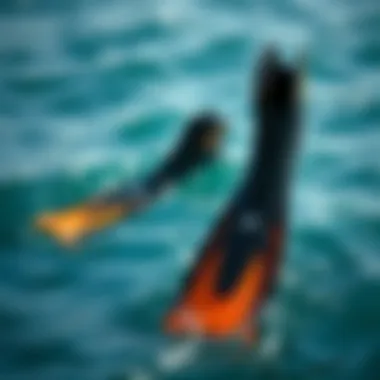

- Kick Efficiency: A fin that is too heavy or not flexible enough can slow down a swimmer. Lightweight, well-designed fins can significantly enhance propulsion without exerting excessive energy.
- Comfort: If fins do not fit correctly or are uncomfortable, swimmers may end up compensating with poor technique, impacting performance negatively.
- Adaptability: Fins must perform well in diverse ocean conditions; choosing durable materials that offer solid design will aid performance in changing environments.
Choosing the Right Fins
Selecting the right fins is pivotal in maximizing your ocean swimming experience. Fins not only enhance propulsion but also influence stability and maneuverability. Not all fins are created equal, and mismatches in choice can lead to discomfort, inefficiency, or even safety issues in challenging conditions. Swimmers must consider various elements to ensure their fins complement their swimming style and the specific environmental challenges they face.
Assessing Skill Level
A novice swimmer may not have the same requirements as an experienced one. Beginners often benefit from fins that offer a larger surface area and supportive features, allowing them to focus on establishing proper kicking technique. More advanced swimmers might prefer fins that allow for greater freedom of movement and fine-tuning of their kicking style. A good way to evaluate skill level is to ask:
- What are my goals in ocean swimming?
- How comfortable am I in the water?
- Am I training for a specific event or just enjoying recreational swims?
Understanding where you stand in your swimming journey can simplify selecting fins that cater to your specific needs.
Evaluating Swimming Style
Your swimming style significantly influences the fin type that works best for you. A flutter kick, for instance, may pair well with short fins, which provide more agility and control. Alternatively, a strong breaststroke swimmer could favor long fins for added propulsion during the glide phase. Consider these questions to gauge your swimming style:
- Do I swim primarily for speed or endurance?
- Am I utilizing a specific kicking style?
- How do I handle turns and transitions in my strokes?
Recognizing your natural swimming rhythm and techniques will help you select fins that enhance rather than hinder your performance in the water.
Considering Water Conditions
Ocean conditions can be formidable. Fins suitable for calm waters may not stand up to challenging waves or strong currents. Assessing the typical conditions you swim in will help in choosing the right fins:
- Calm Water: In serene conditions, lighter fins can enhance your kicking without exhausting your energy.
- Wavy Conditions: Opt for fins with a robust design that offers additional control to navigate through the surf.
- Strong Currents: Here, you’ll want fins that provide maximum thrust to combat the flow of water.
Being honest with yourself about where and how you swim can prevent unnecessary struggles and ensure your fins meet the demands of your swimming services. Finally, it's wise to occasionally test different fins, as what feels comfortable on dry land may be a different story once they're submerged in the ocean.
"The best fins are those that support not just your physical ability but also your comfort and confidence in the water."
By taking these considerations into account—skill level, swimming style, and water conditions—you place yourself in a prime position to pick fins that elevate your ocean swimming experience, making each stroke a stride toward both performance and pleasure.
Fins for Specific Conditions
When it comes to ocean swimming, the water's temperament plays a pivotal role in determining the right fin choice. Each water condition—be it calm, wavy, or marked by strong currents—requires a distinct approach to fin selection. Understanding these variances not only enhances your swimming experience but also maximizes safety and efficiency in the water.
Calm Water Swimming
Swimming in calm waters generally provides a serene and enjoyable experience. In these conditions, fins can serve to amplify your propulsion without the added resistance you'd face in choppier seas. Full foot fins are often recommended here for their ease of use and comfort. They ensure a snug fit, allowing for maximum energy transfer with every kick.
Benefits of using fins in calm water:
- Improved speed: Full foot fins can help maintain a steady glide, making your swim feel almost effortless.
- Less fatigue: With less resistance, swimmers can cover larger distances without tiring as quickly.
- Increased efficiency: Utilizing fins enhances kick strength, providing an effective training tool to improve overall technique.
For those looking to train in calm conditions, it's wise to consider shorter fins. They allow for faster flicks while reducing drag, which can be beneficial for skill development.
Wavy Conditions
Encountering waves presents its own set of challenges for swimmers. Here, the surface can be unpredictable, making it essential to choose fins that allow for stability and maneuverability. Open heel fins, often fitted with an adjustable strap, tend to be favored in these scenarios as they provide a more customized fit.
Key considerations for swimming in wavy conditions:
- Stability: Wider fins can help maintain balance against the rolling waves, reducing the risk of being thrown off your course.
- Maneuverability: Fins with a larger surface area can catch the waves better, offering improved navigation through choppy waters.
- Durability: Wavy conditions can wear on equipment. Fins made from robust materials stand a better chance of withstanding the rigors of ocean swells.
Many swimmers find that practicing in variable wave heights helps build confidence and skill. Choosing the right fin can significantly ease this learning curve.
Strong Currents
In environments with strong currents, the choice of fins becomes critical. The correct pair can provide the necessary grip and thrust needed to navigate swiftly through powerful water flows. For these conditions, fins that are slightly longer and feature a stiffer blade are often recommended. They allow swimmers to kick harder against the current, generating propulsion even in challenging situations.
Considerations for fins in strong currents:
- Grip: Fins that have advanced tread patterns or textured surfaces can offer more traction, essential when facing rapid flows.
- Strength and comfort: Depending on the fin's stiffness, it should enable sustained swimming without causing excessive fatigue or cramping.
- Weight: Heavier fins can sometimes be a disadvantage in fast water as they may slow you down, so striking a balance is vital.
Overall, being mindful of the specific conditions can make or break an ocean swim. With the right fins tailored for calm, wavy, or current-heavy environments, a swimmer not only enhances their efficiency but can navigate the challenges of the ocean with confidence.
Fitting and Comfort
When it comes to swimming in the ocean, the fit and comfort of your fins can make or break your experience. A fin that's too tight can lead to discomfort and even injury, while one that's too loose may slip off during your swim. Ultimately, the right fit ensures optimal performance and enhances your overall swimming experience.
Finding the Right Size
Choosing the right size for your fins isn't just about measuring foot length. It's crucial to consider the width and shape of your foot as well. Here’s what you need to keep in mind when finding the right size:
- Foot Measurement: Start by measuring your foot from heel to toe, then consult the manufacturer's size chart. These charts differ among brands, so don’t assume the size is standard across the board.
- Width Consideration: If you have wider feet, look for fins designed specifically for a wider fit. This will help prevent pinching and provide necessary comfort during prolonged use.
- Try Them On: If possible, physically try on the fins before purchasing. Walk around in them briefly to see how they feel. If you have the option, consider wearing them in water to ensure they stay on snugly without excessive pressure.
"The right fit not only enhances comfort but also ensures maximum control while swimming."
Adjustability Features
Some fins come with adjustable features that can significantly enhance fit and comfort. Here are key aspects to look for in adjusting fins:
- Strap Adjustability: Open heel fins typically boast adjustable straps. These straps allow you to customize the fit according to your foot's unique contours. Adjusting them properly can contribute to reducing any chafing that can happen during long swims.
- Interchangeable Components: Some advanced fin designs allow for customizable parts. For instance, you can swap out the foot pocket for a different size if your foot dimensions change over time, maintaining comfort without needing to buy new fins.
- Quick-Release Mechanisms: Features that allow for easy on-and-off can increase your comfort significantly. Quick-release systems eliminate the hassle of fiddling with your fins, especially in choppy waters or after a tiring swim.
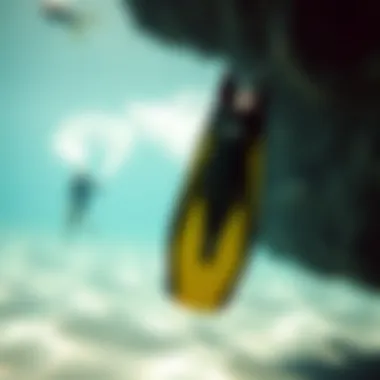
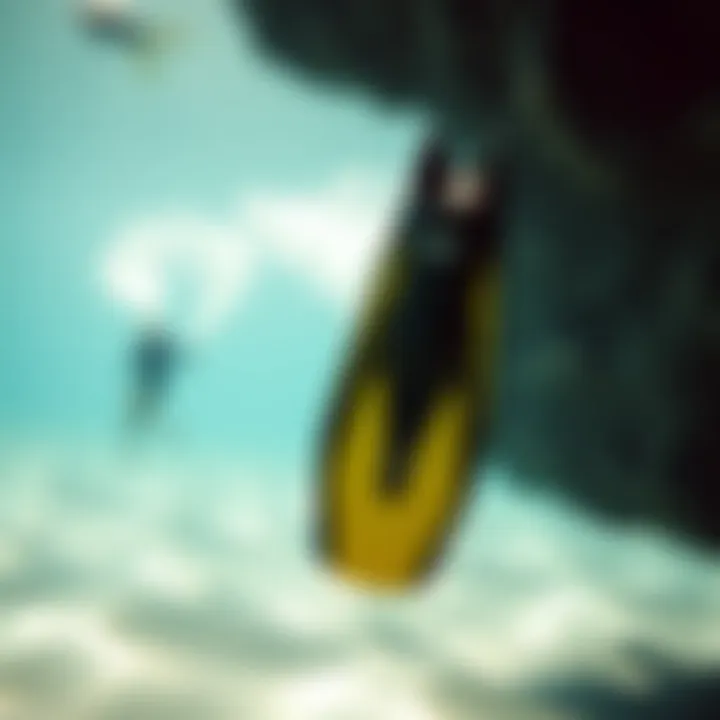
Advanced Fins Technology
In the ever-evolving landscape of swimming gear, fins have seen dramatic advancements in technology. Gone are the days when simply slapping on a pair of rubber fins was the norm. Today, the focus on performance, sustainability, and ergonomics has transformed how fins are designed and produced. This section digs into these high-tech features and how they can influence your ocean swimming experience.
Hydrodynamic Designs
The design of fins plays an immense role in their effectiveness in the water. Hydrodynamic designs streamline the swimmer's movement, reducing water resistance and allowing for a more efficient stroke. One might compare it to slicing through butter compared to plowing through molasses. Features such as varying blade thickness and strategically placed channels are crucial.
- Blade Shape: Fins designed with a tapered shape can navigate through water with ease, enhancing speed.
- Channeling: Fins with grooves or channels direct water flow for better propulsion.
- Flexible Blades: The right balance of stiffness can lead to optimal propulsion without causing leg fatigue.
Swimmers often note that the right fin design can feel like trading in an old sedan for a sports car. This is particularly important in choppy waters, where having a fin that can cut through waves and turbulence can make a substantial difference.
"A well-designed fin is like a well-tuned engine. You feel the power in every stroke."
Eco-Friendly Innovations
Increasing awareness around environmental sustainability is leading to noteworthy innovations in fin production. Many brands are stepping up by using sustainable materials to create eco-friendly fins which do not compromise on performance.
- Recycled Materials: Using repurposed plastics and bio-based composites is becoming the norm for many manufacturers.
- Non-toxic Coatings: Protecting fins from UV damage has advanced with coatings that are safe for marine life.
- Energy-saving Manufacturing: Production processes are shrinking their carbon footprint, ensuring that ocean swimming can go hand-in-hand with ocean conservation.
These eco-friendly innovations are crucial not just for the athletes who use them but also for the preservation of marine ecosystems. When swimmers choose sustainable fins, they are endorsing a narrative that values both sportsmanship and environmental stewardship, illustrating that even small choices can have significant impacts.
Maintenance and Care of Fins
Taking care of your fins is not just about keeping them clean. It's a whole process that can dictate their longevity and performance in the water. Without proper maintenance, fins can wear down faster, leading to poor performance, discomfort, or even injury during ocean swimming. By following a few key practices, swimmers can extend the life of their equipment and improve their overall experience.
Cleaning Techniques
After swimming, it's essential to rinse your fins with fresh water. Salt from the ocean and other residues can damage the material over time. Here’s a simple step-by-step guide to keep your fins in tip-top shape:
- Rinse Immediately: As soon as you get out of the water, rinse the fins under fresh running water to remove any salt or sand. This quick action can prevent buildup that could corrode the material.
- Gentle Scrubbing: If there’s stubborn dirt or grime, use a soft brush or sponge. Harsh scrubbing tools should be avoided as they can scratch or damage the surface.
- Soap Optional: If fins are particularly dirty, a mild detergent can be used. Ensure it’s non-toxic and biodegradable to avoid harming aquatic life.
- Dry Carefully: Let fins dry completely before storing them. This helps prevent mold and bad odors.
"A little care goes a long way; neglect can lead to diminished performance and unnecessary costs."
Storage Tips
Proper storage is just as vital as cleaning when it comes to maintaining your fins. Here are some considerations:
- Find a Cool, Dry Place: Store your fins in a temperature-controlled environment, away from direct sunlight and extreme heat. Heat can warp the material, affecting performance and fit.
- Avoid Heavy Weight on Top: Never stack heavy items on your fins during storage. This can deform their shape, reducing their effectiveness.
- Use a Fin Bag: Consider investing in a dedicated fin bag or case to avoid scratches and other damage. This also helps in keeping them organized and easy to find when needed.
- Airflow Matters: If possible, store fins in a well-ventilated area. Proper airflow can help prevent mold growth which often stems from damp environments.
By implementing these maintenance and care techniques, swimmers can enhance their experience while ensuring their fins serve them well for many tides to come.
Expert Recommendations
When it comes to fins for ocean swimming, expert guidance plays a crucial role. The right advice can lead swimmers to make informed decisions that enhance their performance and enjoyment in the water. Swim coaches, experienced athletes, and specialized retailers can provide insights that help in choosing the right fins tailored to individual needs. The diversity of ocean conditions requires a nuanced understanding of fin technology and suitability, thus making expert recommendations invaluable.
Top Picks for Beginners
For beginners, the focus should be on fins that prioritize comfort and ease of use.
- Cressi Palau Short Fins: These fins are flexible and lightweight, making them perfect for those just starting. The full foot design offers a snug fit, reducing the chances of blisters.
- Scubapro Go Fin: Known for their comfort, these open heel fins can be adjusted for a perfect fit, allowing for a wider range of shoe sizes. They are ideal for beginners who may want to use them in different water conditions.
"Choosing the right fins is like picking the right pair of shoes; comfort can make or break your experience in the ocean."
Additionally, consider fins with a shorter blade, as they demand less energy, enabling novices to swim longer without undue fatigue. A stiffer fin might not be the best choice; a softer one can aid in building strength without overwhelming a new swimmer.
Fins for Advanced Swimmers
Advanced swimmers often need fins that cater to their specific technique and performance goals. Here, refinement in choice is essential.
- Speedo Biofuse Fins: These fins adapt well to changing water conditions and are designed for those looking to increase power and speed. The soft silicone material offers comfort while still providing the necessary propulsion.
- Mares Avanti Superchannel Fins: Featuring a unique channeling design, they enhance propulsion through the water, allowing swimmers to maintain high speeds while conserving energy.
Swimmers at this level may also explore specialized fins, such as those designed for underwater training or muscle conditioning. The emphasis should be on finding fins that complement their stroke technique and improve efficiency rather than simply aiding propulsion.
In summary, whether someone is just dipping their toes in the ocean or slicing through waves like a pro, selecting fins suited to their experience level can make a sizable difference. Relying on expert recommendations can ensure a rewarding and enjoyable swimming journey.
Epilogue
In wrapping up this comprehensive guide on selecting fins for ocean swimming, it’s crucial to underline the importance of a well-informed choice. Each element discussed throughout the article underscores a significant aspect of fin selection, which can directly influence a swimmer's experience and performance. Having the right fins not only enhances propulsion and stability but also improves safety, particularly in varied ocean conditions.
Summarizing Key Points
To summarize, here are the key considerations highlighted in this guide:
- Understanding Ocean Dynamics: Knowledge of ocean conditions, such as waves and currents, is vital for selecting appropriate fins.
- Types of Fins: Choosing between full foot, open heel, short, or long fins will depend on personal swimming style and skill levels.
- Material Choices: Silicone and rubber both have their pros and cons, affecting comfort and performance.
- Fit and Comfort: Ensuring the right size and fit is essential; poorly fitted fins can lead to discomfort or reduced efficiency.
- Specific Use Cases: Different fins serve specific purposes — from calm waters to challenging currents.
- Maintenance: Proper care of fins prolongs their life and enhances performance.
These points weave together to form a comprehensive understanding of the nuances involved in fin selection.
Final Thoughts on Ocean Swimming
Ocean swimming is both a challenging and exhilarating endeavor, and the right fins are a critical piece of the puzzle. Swimmers must consider factors like personal comfort, environmental conditions, and skill level to effectively harness the benefits of fin technology. As technology advances, more eco-friendly materials and innovations enter the market, which will benefit not only individual swimmers but also marine environments.
In the end, each swimmer's journey is unique, and their choice of fins can either enhance or detract from that experience. Whether one is a seasoned athlete or a novice, understanding and selecting the optimal fins can profoundly influence performance and enjoyment in the bracing ocean waters. The ocean awaits, and with the right equipment, one’s swimming can transform from a mere activity to a fulfilling adventure.
"The sea, once it casts its spell, holds one in its net of wonder forever."
— Jacques Cousteau
For more insights on ocean swimming and equipment, you might want to check resources such as Wikipedia, Britannica, or forums like Reddit for discussions among fellow enthusiasts.















